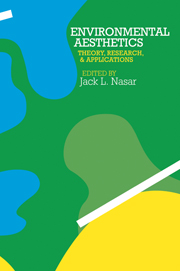Book contents
- Frontmatter
- Contents
- List of figures
- List of tables
- List of contributors and participants
- Acknowledgments
- Preface
- Section I Theory
- Section II Empirical studies
- Editor's introduction
- A Methodological comments
- B Architectural interiors
- C Architectural exteriors
- Editor's introduction
- 14 A study of meaning and architecture
- 15 Predicting user responses to buildings
- 16 Dimensions in the perception of architecture: identification and interpretation of dimensions of similarity
- 17 Contextual compatibility in architecture: an issue of personal taste?
- D Urban scenes
- E Natural and rural scenes
- Section III Applications
- References
- Index of authors
- Subject index
14 - A study of meaning and architecture
Published online by Cambridge University Press: 05 September 2013
- Frontmatter
- Contents
- List of figures
- List of tables
- List of contributors and participants
- Acknowledgments
- Preface
- Section I Theory
- Section II Empirical studies
- Editor's introduction
- A Methodological comments
- B Architectural interiors
- C Architectural exteriors
- Editor's introduction
- 14 A study of meaning and architecture
- 15 Predicting user responses to buildings
- 16 Dimensions in the perception of architecture: identification and interpretation of dimensions of similarity
- 17 Contextual compatibility in architecture: an issue of personal taste?
- D Urban scenes
- E Natural and rural scenes
- Section III Applications
- References
- Index of authors
- Subject index
Summary
There are few forms in architecture to which people do not attach some meaning by way of convention, use, purpose, or value. This includes the very mundane realization that a wood panel approximately 3 feet wide by 7 feet high is a door (object that one opens to pass through), the more subtle feelings of warmth and protection at the entrance to some buildings, and some of the most profound experiences of beauty and art. Indeed, the transmission of meaning through the architectural medium is essential to both the use and the enjoyment of architecture. Meaning is of considerable importance in perception (Creelman, 1966), “one of the most important determinants of human behavior” (Osgood, Suci, and Tannenbaum, 1957, p. 10), and unquestionably involved with human feelings. Furthermore, it has been argued by architects and planners alike that in an increasing number of situations, the underload, overload, or confusion of meaning in architecture has become such that both the use and the enjoyment of architecture are seriously jeopardized (Brown, undated; McHarg, 1962). In consequence, it would seem appropriate at this time to undertake serious studies of the nature of architectural meaning to learn what is needed to create physical environments that can be satisfactorily perceived, felt, and used.
The research reported here was addressed to this problem, taking the point of view that the forms, colors, spaces, and other qualities of architecture are media through which architects communicate to the users of their buildings, and focusing on the “fidelity” of this communication.
- Type
- Chapter
- Information
- Environmental AestheticsTheory, Research, and Application, pp. 175 - 194Publisher: Cambridge University PressPrint publication year: 1988
- 8
- Cited by



